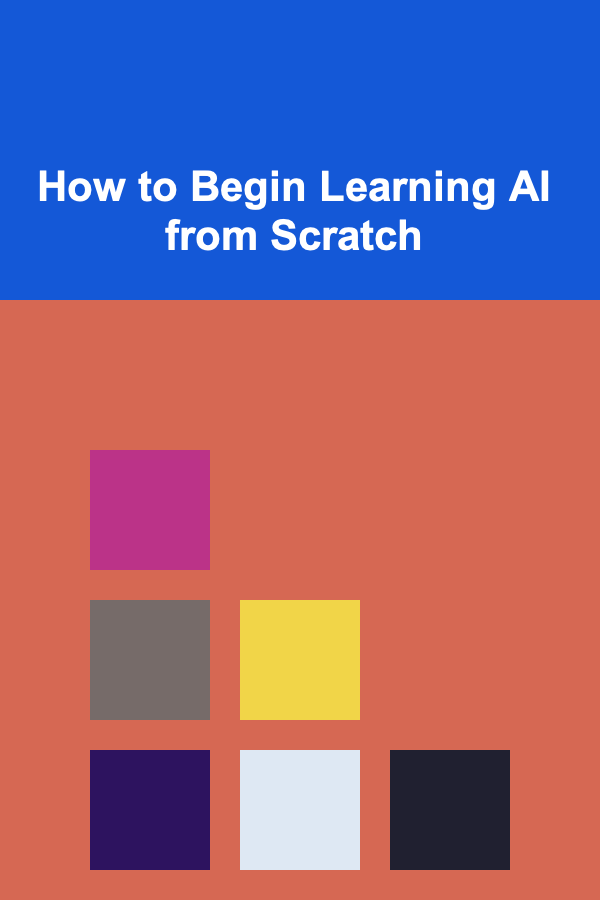
How to Begin Learning AI from Scratch
ebook include PDF & Audio bundle (Micro Guide)
$12.99$8.99
Limited Time Offer! Order within the next:

Artificial Intelligence (AI) is one of the most transformative technologies of our time. Its application spans across industries such as healthcare, finance, education, and entertainment. With AI becoming increasingly prevalent, it's not surprising that many people are eager to learn how to work with it, regardless of their background or expertise.
Learning AI from scratch, however, can seem like a daunting task, especially for those without a deep technical background. Fortunately, with the right resources, a structured approach, and consistent effort, anyone can embark on the journey of learning AI and master its core concepts and applications.
In this article, we'll outline the steps and resources required to begin learning AI from scratch, starting from the basics and advancing to more specialized topics.
Understanding the Basics: What Is AI?
Before diving into the technicalities, it's important to first understand what AI is and what it encompasses. At its core, AI refers to the simulation of human intelligence in machines that are programmed to think and learn like humans. This includes a wide range of technologies and techniques, such as machine learning (ML), natural language processing (NLP), computer vision, and robotics.
AI can be categorized into two main types:
- Narrow AI (Weak AI): This type of AI is designed to handle specific tasks. It's what most AI systems today are, such as virtual assistants (Siri, Alexa), recommendation systems (Netflix, YouTube), and image recognition software.
- General AI (Strong AI): This is a theoretical type of AI that possesses the ability to understand, learn, and apply intelligence across a wide range of tasks, similar to a human. General AI has not yet been achieved but remains a topic of research and speculation.
To begin learning AI, you should have a clear understanding of these basic concepts. This foundational knowledge will guide your learning as you progress through more advanced topics.
Prerequisites: What Skills Do You Need?
Before you start learning AI, it's important to assess your current skill set. AI, at its core, involves mathematics, programming, and domain knowledge. Here's a breakdown of the essential skills you'll need:
a. Mathematics
AI heavily relies on mathematical concepts, especially in areas like machine learning and deep learning. Here are the main mathematical areas you should focus on:
- Linear Algebra: This branch of mathematics deals with vectors, matrices, and linear transformations, which are critical for understanding machine learning algorithms, especially in deep learning.
- Calculus: Calculus, particularly derivatives and integrals, is important for optimizing machine learning models, especially when you work with gradient-based optimization techniques like gradient descent.
- Probability and Statistics: AI systems make decisions based on data, and statistics is crucial for understanding data distributions, hypothesis testing, and the concepts of uncertainty. Understanding probability is also essential for models like Bayesian networks.
- Optimization: AI involves optimizing models to minimize errors or loss functions, which is a core part of training algorithms. Techniques such as gradient descent and convex optimization are frequently used.
If you are not already comfortable with these concepts, it's a good idea to brush up on them before diving into AI.
b. Programming
Programming is another essential skill for learning AI. The most commonly used programming language in AI is Python due to its simplicity and vast collection of libraries dedicated to AI and data science. Some key areas to focus on:
- Python Basics: Learn Python syntax, functions, loops, conditionals, and data structures like lists, dictionaries, and sets.
- Data Handling: Learn how to work with data using libraries such as NumPy (for numerical operations) and Pandas (for data manipulation).
- Visualization: Understand how to use libraries like Matplotlib and Seaborn to visualize data and model performance.
- Libraries and Frameworks: Once you are comfortable with Python, you should learn AI-specific libraries such as TensorFlow, Keras, and PyTorch for machine learning, as well as OpenCV for computer vision and NLTK for natural language processing.
If you're new to programming, start by learning Python through online tutorials, books, and interactive platforms.
Start with Machine Learning (ML)
Once you've built a solid foundation in mathematics and programming, you can begin learning the core of AI: Machine Learning (ML). ML is a subset of AI that allows computers to learn from data and make predictions or decisions without being explicitly programmed.
a. Understanding the Basics of Machine Learning
There are three main types of machine learning:
- Supervised Learning: In supervised learning, the model is trained on labeled data, meaning the input data is paired with the correct output. The goal is for the model to learn a mapping from inputs to outputs. Common algorithms include linear regression, decision trees, and support vector machines.
- Unsupervised Learning: In unsupervised learning, the model is trained on unlabeled data, and the goal is to identify patterns or structures in the data. Common techniques include clustering (e.g., k-means) and dimensionality reduction (e.g., PCA).
- Reinforcement Learning: This type of learning involves training agents to make decisions by interacting with an environment. The agent receives rewards or penalties based on its actions and learns over time. Reinforcement learning is used in applications like robotics, gaming, and autonomous driving.
b. Key Concepts in Machine Learning
- Training and Testing Data: To evaluate the performance of machine learning models, it's important to split your data into training and testing sets. The model is trained on the training set, and its performance is evaluated on the testing set.
- Feature Engineering: Feature engineering is the process of selecting and transforming raw data into features that better represent the underlying patterns of the problem.
- Model Evaluation: You should understand how to evaluate the performance of a machine learning model using metrics such as accuracy, precision, recall, and F1-score. Cross-validation is also a technique used to improve model performance.
c. Popular Machine Learning Algorithms
Start learning with basic algorithms like:
- Linear Regression: For predicting continuous outcomes.
- Logistic Regression: For binary classification problems.
- Decision Trees: For both classification and regression tasks.
- K-Nearest Neighbors (KNN): A simple but effective classification algorithm.
- Support Vector Machines (SVM): For classification tasks, especially when the data is non-linear.
Once you're comfortable with these algorithms, you can move on to more advanced topics like neural networks and deep learning.
Diving into Deep Learning
Deep Learning (DL) is a subfield of machine learning that focuses on neural networks with many layers (hence "deep"). Deep learning has enabled remarkable advances in fields such as image recognition, natural language processing, and speech recognition.
a. Understanding Neural Networks
A neural network consists of layers of interconnected nodes (neurons), with each node performing a simple computation. The network learns by adjusting the weights of the connections between the nodes during training, using algorithms like backpropagation.
There are different types of neural networks, including:
- Feedforward Neural Networks: The simplest type of neural network, where information flows from input to output in a single direction.
- Convolutional Neural Networks (CNNs): Used primarily for image-related tasks, CNNs use convolutional layers to automatically detect features in images.
- Recurrent Neural Networks (RNNs): Designed for sequential data (like time series or text), RNNs have connections that loop back, allowing them to remember information over time.
b. Popular Deep Learning Frameworks
Deep learning models are typically built using specialized frameworks like:
- TensorFlow: An open-source framework developed by Google for building and training machine learning models.
- Keras: A high-level neural networks API that runs on top of TensorFlow, making it easier to design and experiment with deep learning models.
- PyTorch: Another popular framework that is widely used in both academic research and industry for deep learning tasks.
c. Key Deep Learning Concepts
- Backpropagation: The process of adjusting weights in a neural network by propagating the error backward from the output layer to the input layer.
- Activation Functions: Functions like ReLU, Sigmoid, and Tanh that introduce non-linearity to the network, enabling it to learn complex patterns.
- Overfitting: A situation where a model learns the noise in the training data, leading to poor performance on unseen data. Techniques like dropout, early stopping, and regularization can help prevent overfitting.
Practical Applications of AI
Once you've grasped the basics of AI and machine learning, you can start applying what you've learned to real-world problems. Here are some of the most popular applications of AI:
a. Natural Language Processing (NLP)
NLP involves using AI to process and analyze human language. Applications include machine translation (e.g., Google Translate), chatbots, sentiment analysis, and speech recognition.
b. Computer Vision
Computer vision focuses on enabling machines to interpret and understand visual data from the world. It is used in image classification, object detection, facial recognition, and autonomous vehicles.
c. Reinforcement Learning
Reinforcement learning is used in applications such as robotics, gaming (e.g., AlphaGo), and autonomous systems, where an agent learns to make decisions by interacting with an environment.
d. AI in Healthcare
AI is transforming healthcare by enabling early diagnosis, personalized treatments, and drug discovery. It can analyze medical images, predict patient outcomes, and assist in clinical decision-making.
Continuous Learning and Staying Updated
AI is an ever-evolving field, and to stay competitive, you must continue learning. Here are some tips:
- Read Research Papers: Follow AI conferences like NeurIPS, CVPR, and ICML to stay up-to-date with the latest research.
- Join Online Communities: Participate in AI-focused forums, Reddit threads, and Stack Overflow to learn from others and share your knowledge.
- Work on Projects: Build your own AI projects to practice and improve your skills. Platforms like Kaggle offer datasets and challenges that allow you to compete with others and learn hands-on.
- Take Advanced Courses: Once you've mastered the basics, consider taking more advanced courses in AI, deep learning, and specific applications like NLP or computer vision.
Conclusion
Starting to learn AI from scratch may seem overwhelming, but by breaking the process into manageable steps, anyone can embark on this exciting journey. Start by building a solid foundation in mathematics and programming, then move on to machine learning, deep learning, and real-world applications. AI is a rapidly growing field with endless possibilities, and with continuous learning and hands-on practice, you can become an expert and contribute to shaping the future of this transformative technology.

How to Care for Your Hardwood Floors to Make Them Last Longer
Read More
How to Create a Family Water Fight for Summer Fun
Read More
How to Develop a Blockchain for Voting Auditing
Read More
How to Start Financial Planning for Emergencies and Secure Your Future
Read More
How to Use Minimalist Decor for Your Home Party
Read More
Networking 101: Building Connections That Lead to Job Offers
Read MoreOther Products

How to Care for Your Hardwood Floors to Make Them Last Longer
Read More
How to Create a Family Water Fight for Summer Fun
Read More
How to Develop a Blockchain for Voting Auditing
Read More
How to Start Financial Planning for Emergencies and Secure Your Future
Read More
How to Use Minimalist Decor for Your Home Party
Read More